In “Reaping the Rewards,” I take a look at the finished product from a crowdfunding campaign. Sagrada is a beautiful dice-placement game about crafting stained-glass windows designed by Adrian Adamescu and Daryl Andrew. It was funded on Kickstarter in October 2016, and delivered to backers in April this year. This review is based on my original Kickstarter Tabletop Alert, updated to reflect the final components.
At a glance: Sagrada is a dice-placement game for 2 to 4 players, ages 14 and up, and takes about half an hour to play. It will be available in stores and online next week (May 17), with a retail price of $39.99. The theme is about building stained-glass windows, using colored dice on template cards. I think younger players would be able to handle it, maybe about 10 and up.
Sagrada is GeekDad Approved!

Components
- 90 dice in 5 colors (red, yellow, green, blue, purple)
- 4 Window Frame player boards
- 12 Window Pattern cards
- 10 Public Objective cards
- 5 Private Objective cards
- 12 Tool cards
- Dice bag
- 24 Favor tokens
- Favor token bag
- Round & scoring track
- 4 scoring markers
- Master Artisan card
The dice are 12mm transparent dice—so they’re a little smaller than the standard dice from most games, but the transparent colors really add to the stained-glass theme. The dice bag is a nice, large cloth bag that’s big enough to reach in, mix up the dice, and pull dice out without getting your hand stuck. However, the cloth is stiff enough that the drawstring doesn’t actually stay shut if you don’t tie it. The same thing is true of the favor token bag, which is a small black cloth bag—the string doesn’t stay tight. The favor tokens are standard clear glass beads.

The window pattern cards are double-sided, with one pattern on each side, and they fit into the window frame boards. Each window pattern is marked with 3 to 6 dots at the bottom right, indicating how many favor tokens you get if you use that pattern (the more dots, the more difficult the pattern). The window frame boards are really beautiful. Of course, you could play the game without them and the top of the frame is purely decorative, but if you’re going to play a game about stained-glass windows, then it makes sense to have as much decoration as possible.
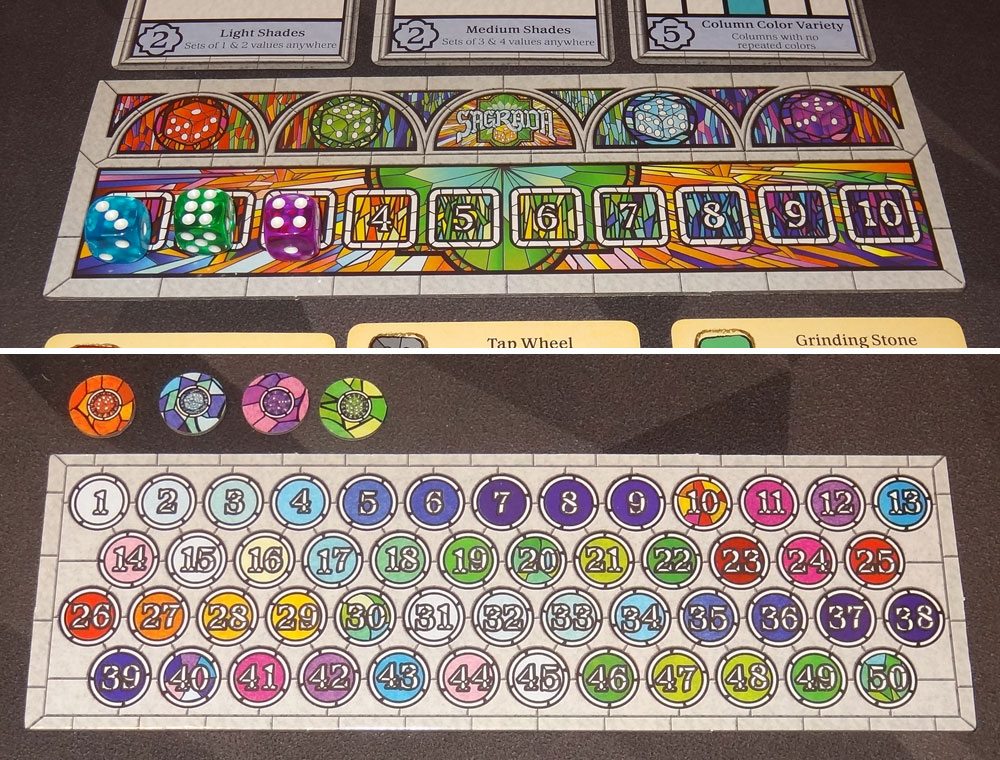
The round track helps you keep track of the 10 rounds of the game, and then flips over to act as the scoring track on the reverse side. The scoring tokens match the player boards, and there’s a “50” on the reverse side in case you score more than 50 points. I do wish the dice/50 on these were a little larger, though.
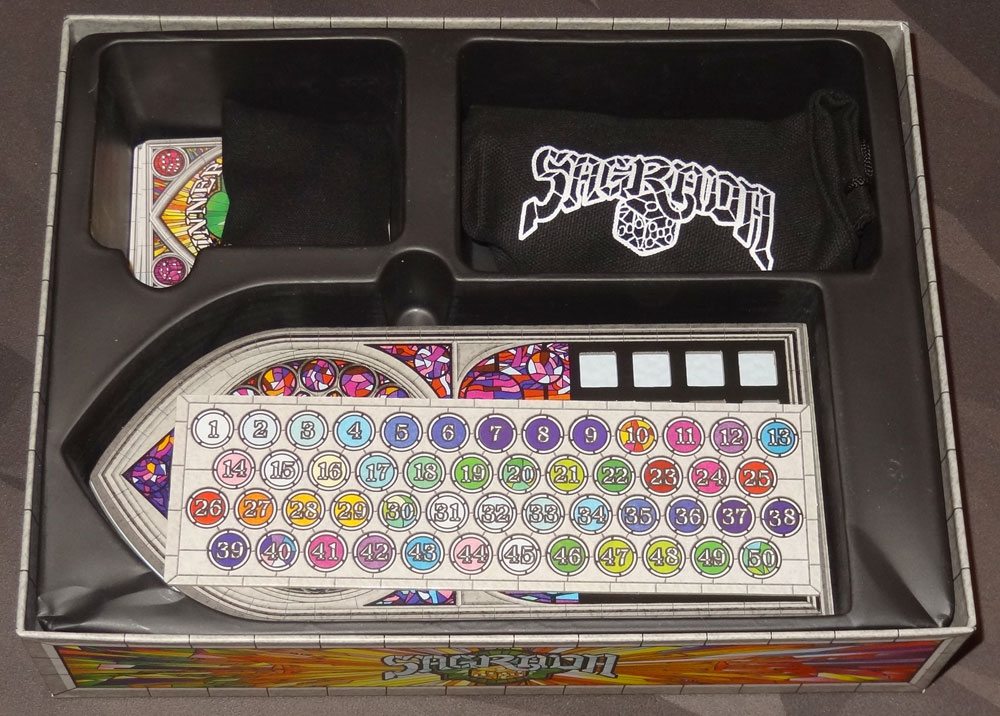
Those boards, however, do mean that the game box is pretty large—comparable to Floodgate Games’ Epic Resort. The box insert has sufficient space for everything, though the plastic is a little flimsy. The window pattern cards have a slot below the frame boards.
The stained-glass artwork on the cards, by Peter Wocken, is lovely and really helps you get into the theme of the game. The tool cards are less pretty, just illustrating how each tool works. The Master Artisan Card has instructions on the back, telling you to post a selfie with the card when you win. I’d first seen something like this in some of Tasty Minstrel Games’ titles, and it’s a way to get fans to promote your game—clever!
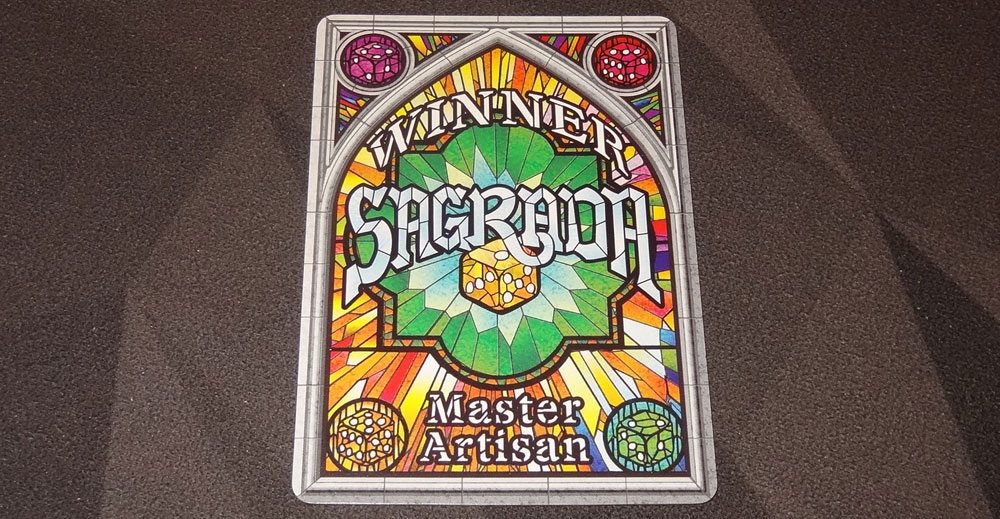
How to Play
The goal is to score the most points after 10 rounds of play, by fulfilling public and private objectives.
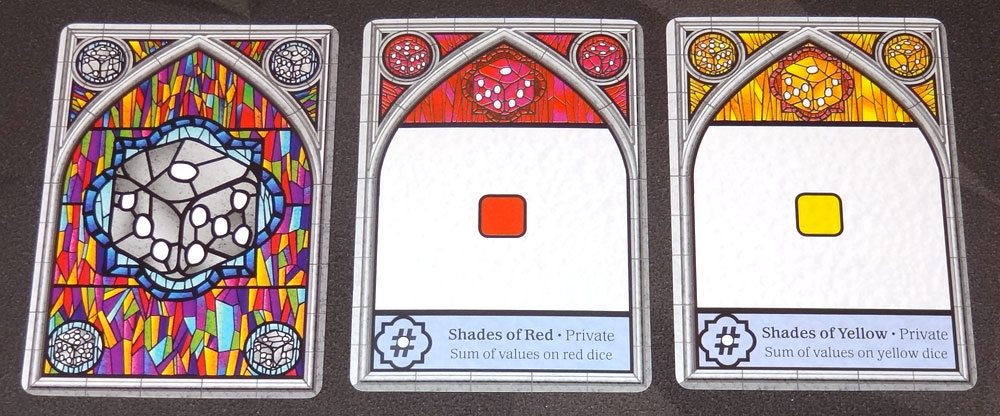
To set up, each player gets 2 window pattern cards and a player board. Each player chooses one of the 4 possible window patterns, and slides the card into the player board so that window is visible, and then takes the number of favor tokens indicated on the pattern card. Put all the dice in the dice bag. Shuffle the tool cards and lay out 3 on the table. Shuffle the public objective cards and place 3 face-up on the table. Give each player a random private objective card. The start player takes the dice bag.
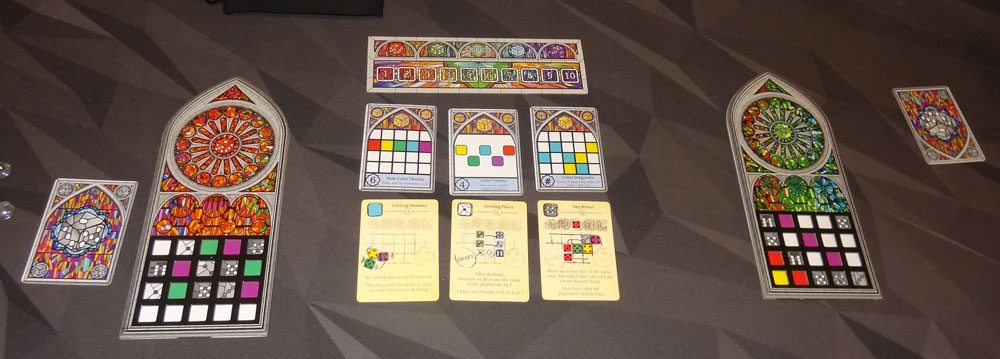
Each round, the start player will draw dice from the bag and roll them: the number is based on the number of players, because there will be enough for each player to take 2 dice, with one remaining. Each player will take a turn in turn order, and then each player will take a second turn in reverse order. On your turn, you may draft 1 die and place it on your window and/or use 1 tool (in any order).
The first die you place on your window must be on an edge. All dice must match the requirements printed on the window card, if any—colors match colors, numbers (called “shades” in this game) must match numbers. After the first die, all subsequent dice must be adjacent (either orthogonally or diagonally) to an existing die. Also, you may never place a die orthogonally adjacent to another die of the same color or shade—that’s the part that is a little like Sudoku.

To use a tool, place favor tokens on the tool card to use its ability. If the tool card is empty (i.e., it hasn’t been used yet), you pay 1 favor token; if it already has tokens on it, it costs 2 tokens to use. (The color/number at the top left of the tool card is only for solo play.)
After each player has had two turns, any remaining dice are placed on the round track for that round, and then the dice bag is passed to the next player.

If, at any point, you find an illegal die placement on a window, that player must remove dice until all restrictions are obeyed—those dice are permanently lost.
At the end of 10 rounds, the game ends, and you score your windows.
You get points for fulfilling the public objectives, which will award points for certain combinations—for instance, having sets of 3s and 4s, or rows with no color duplicates. Private objectives will state a particular color: you get 1 point per pip for each die of that color. You add 1 point per favor token you have left, and then lose 1 point for each unfilled space on your window card.
The highest score wins: ties go to the most points from private objectives, then most favor tokens, and then reverse turn order in the final round.

There are solo rules included as well: you set up with 2 public objectives and 1 private objective, and use 1 to 5 tools depending on what difficulty level you want. Each round, you pull 4 dice from the bag, and then take 2 turns per round. Instead of favor tokens (which are not used at all in the solo game), you spend dice from the dice pool to use the tools (the die must match the tool card), but each tool may only be used once. Empty spaces are -3 points at the end of the game. The goal is to score more points than the total of the dice on the Round Track, so using tools reduces the score you need to beat because those dice have been removed.
The Verdict
When I first saw the prototype of Sagrada at Gen Con, I liked it immediately. It’s beautiful to look at, but it also has a puzzle aspect that reminded me of Sudoku, though it’s not strictly the same thing. And while I love sci-fi and zombies and the wild west as much as anyone, it’s always refreshing to see a game with a seldom seen theme.
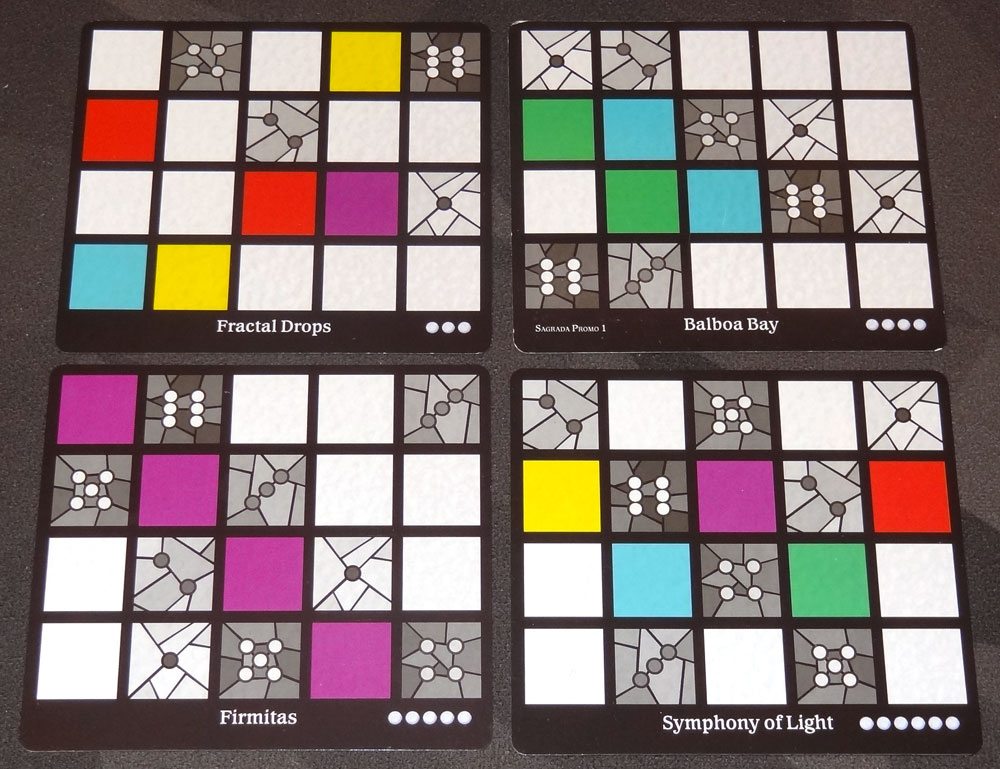
The gameplay is pretty easy to teach: draft dice, use special powers on the tools, get as many objectives as you can while matching your pattern. For the most part, everything “clicks” the first time you play it, so you can focus on your choices rather than trying to learn the rules. There were just a few things that players needed reminders of: for instance, the fact that tools cost 1 favor token at first but then go up to 2. And, as easy as it is to understand the “no identical colors or shades next to each other” rule, inevitably a player will look down and realize that they have two 3s next to each other halfway through the game.
That Sudoku element of not placing similar dice next to each other seems like a really easy rule—after all, it’s just right next to each other, not in an entire row or column, as it would be in actual Sudoku. However, when placing dice you also have to take into account the requirements on your particular window pattern. It can be very easy to trap yourself: for instance, you have a spot that requires a 4, so you place a green 4 there… only to realize later that a space next to it requires green, and therefore can’t be filled. Or, you place dice around a space and realize you’ve severely limited what can go there: if you surround a space with different numbers and colors, you have very few options for what can be placed there.

And then, of course, there are the objectives. The private objectives are all color-based: each player will have one of the five colors, and you try to just maximize all of the dice of that color for bonus points. The public objectives, however, require particular sets of dice: for instance, the “row/column variety” objectives give you bonuses for having no repeats across rows or columns. If that’s the case, you not only have to match your own pattern, but you’re trying to figure out if it’s possible not to repeat. Combining your private and public objectives with your window pattern to maximize your score makes for a really great puzzle.

The tool cards, named after glassworking tools, are most often used to fix things—like when you realize there are no dice left in the pool that will fit on your window. Some tools let you move dice around, manipulate dice, reroll dice in the pool, or even steal dice from the round track. However, using them is expensive—you’re spending 1 or 2 points per use, and you only have so many favor tokens to begin with, so you need to make them count. I like that you’ve got a way to get yourself out of a sticky situation, but that it’s not easy or cheap.
There isn’t a lot of direct player interaction in Sagrada—you’re all working on your own windows, and you don’t get to break or damage somebody else’s window. However, it is a drafting game: you’re all drawing from the same pool of dice. So that means there’s plenty of opportunity to take the die that another player has been waiting for, if you’re paying attention (and mean). I do like the fact that the turn order goes clockwise and then in reverse—it means that the last player will get to pick two dice in a row, and it balances out a little bit of the disadvantage of picking last.
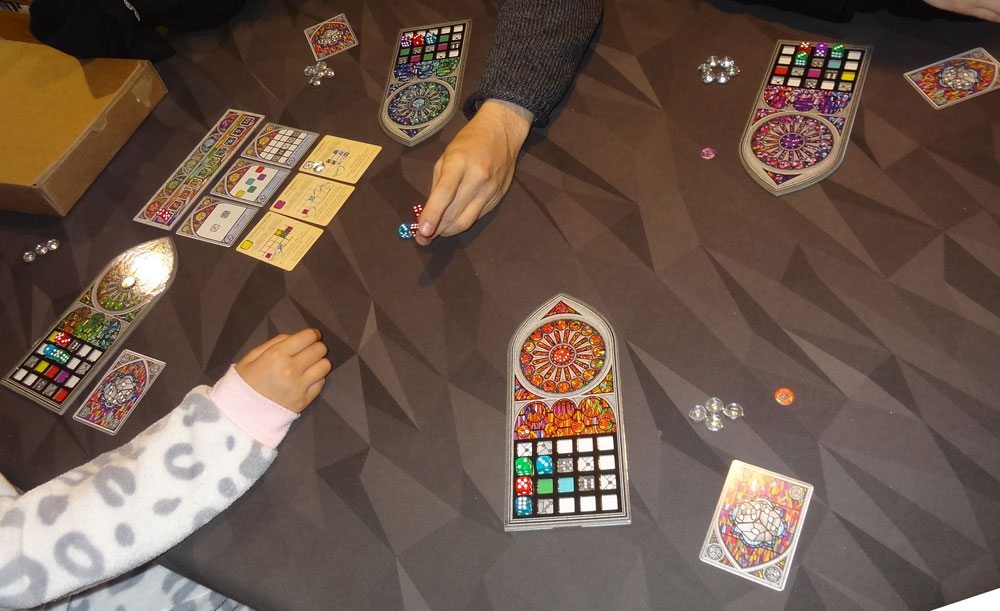
Sagrada has a good bit of chance, of course: which patterns you get, which objectives and tools are dealt out, which colors are drawn, and which numbers are rolled each round. But with the drafting and the tools, there’s still room for strategy. After all, a master artist can make beauty out of whatever materials are at hand, right?
I think Sagrada is a lovely game, and the finished version turned out to be gorgeous. If you like Sudoku, or stained glass, or lots of dice, you should definitely check it out.
Disclosure: I received a review copy of this game.






